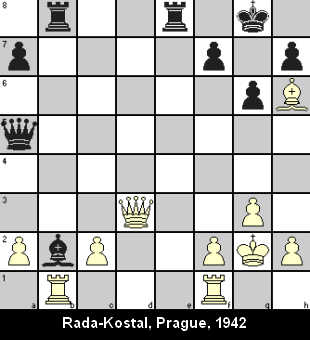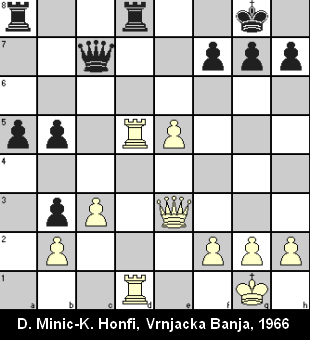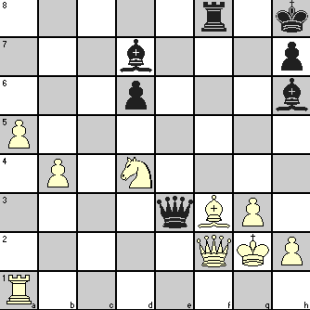8. Forcing overload on opponent’s important defensive piece
Overload is having to bear more load than what can be sustained, resulting in a breakdown. In chess, a piece gets overloaded when it has to perform multiple duties (like having to defend two pieces) or needs to be at two different positions at the same time (which is not possible) to face the different threats posed by the attacker. It is obvious that the overloaded piece has to give up one or more of its functions, creating serious weaknesses in the defender’s position that can be exploited by the attacker.
See this position that occured after 19 moves in the game.
The game went:
| 20. | Rxb2 | Rxb2 | |||
| 21. | Qd4 | Qe5 | |||
| 22. | Re1 | Resigns | The Black Queen has to guard against too many threats and gets overloaded. If it tries to save itself by 22… Qxe1, mate occurs at g7. If it tries to meet the mate threat by 22… Qxd4, Black is exposed to another mate threat by 23. Rxe8# |
Following position with White to move after 22 moves have been played illustrates another Black Queen with too much on her hands.
Because of White’s threat of a backrank mate, both the Black Queen and the Rook at a8 have to remain in contact with the Rook at d8. To exploit the weakness in Black’s position, White played 23. Qa7 and Black resigned. The Black Queen had to guard itself as also the Rook and became overloaded. If Black Queen retreats to the back rank, White simply captures 24. Qxa8 and the mate threat reappears.
In the following position after White’s 33rd move in a game played between C. Lutz (White) and V. Kramnik (Black) in 1995, Black creates a series of overloads on White’s pieces. These practically force White’s responses and make him capitulate after another two moves.
It went as follows:
| 33. | … | Bh3+ | The White King is overloaded as it has to save itself from check as also guard the White Queen, so it has to move to g1 |
||
| 34. | Kg1 | Qc3 | The White Rook is overloaded as it has to guard the base rank against Black’s 35. … Qc1+ as also the e3 square to prevent 35. … Be3), forcing it to e1 |
||
| 35. | Re1 | Bd2 | Black keeps the White Rook under overload as it still has to guard the base rank and the e3 square. Black cannot avoid a quick mate without incurring severe losses. If he tries 36. Nb5, then 36. … Qxf3 37. QXf3 (37. Qxd2 Qf1+ 38. Rxf1 Rxf1#) Rxf3 and mate is only a few moves away e.g. 38. Rd1 Be3+ 39. Kh1 Rf2 40. Rxd6 Bg2+ 41. Kg1 Rd2# |





One Comment
Tactics puzzles are definately the best way to improve. My advice is to do five minutes worth of tactics puzzles per day. Don’t spend too much time on any one tactic. Just a minute or two, and try to solve it. Then check to see if you found the correct solution. It is important to do puzzles that have the solutions available but hidden, so you can check to see if you did them right, but you don’t need to get each one. You just need to see it, try to solve it, check for the solution and move quickly to the next. Lots of exposure to the patterns will create pattern recognition over time.